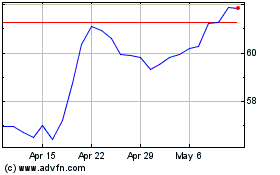WSJ Tax Guide 2019: The Banking Industry -- Journal Report
February 15 2019 - 8:29AM
Dow Jones News
Banks have been among the biggest beneficiaries of the tax
overhaul, reaping billions of dollars in savings after the
corporate tax rate was cut to 21% from 35%.
In the past, banks had tended to pay more in taxes than big
companies in other sectors, since so much of their business is
centered in the U.S. That means the big drop in the tax rate
benefited them even more.
JPMorgan Chase, Bank of America and Wells Fargo all had
effective tax rates in the high teens or low 20s during 2018,
excluding one-time items -- a sharp drop from the past, when the
biggest banks' tax rates tended to be in the high 20s or low
30s.
That meant the banks kept much more of the earnings they
generated. Together, the four biggest national banks -- JPMorgan,
BofA, Wells Fargo and Citigroup -- saved more than $11 billion in
2018 by paying taxes at their new lower effective rates, according
to an analysis by The Wall Street Journal.
Some of those profits flowed back to bank employees. Some banks
said they would give $1,000 bonuses to many employees, raise their
minimum wage to $15 an hour or higher, or both.
[DOWNLOAD THE E-BOOK: "The New World of Taxes: 2019"]
Banks had to go through some pain first to reach those benefits.
Within weeks after the tax overhaul was enacted, many big banks
recorded big upfront charges to their 2017 earnings that the new
law required them to take immediately, largely to write down the
value of their deferred tax assets and record one-time taxes on
their earnings from outside the U.S. Citigroup took the biggest
hit, $22.6 billion, but other banks had sizable charges as well --
$4.4 billion at Goldman Sachs, and $2.9 billion at BofA.
But once past that, the lighter tax bills boosted the banks'
financial performance, and will keep doing so in 2019. Wells Fargo,
for instance, has said it expects its effective tax rate to be
about 18% in 2019, excluding any unanticipated items.
One thing the lower tax rate won't do any longer, however, is
contribute to banks' year-over-year earnings growth. In 2018, the
banks' growth rates benefited from comparing current periods with
the new lower tax rate against year-ago periods with the old higher
tax rate -- and banks derived a big portion of their growth from
those savings.
Michael Rapoport
Write to michael.rapoport@wsj.com
(END) Dow Jones Newswires
February 15, 2019 08:14 ET (13:14 GMT)
Copyright (c) 2019 Dow Jones & Company, Inc.
Wells Fargo (NYSE:WFC)
Historical Stock Chart
From Aug 2024 to Sep 2024

Wells Fargo (NYSE:WFC)
Historical Stock Chart
From Sep 2023 to Sep 2024
